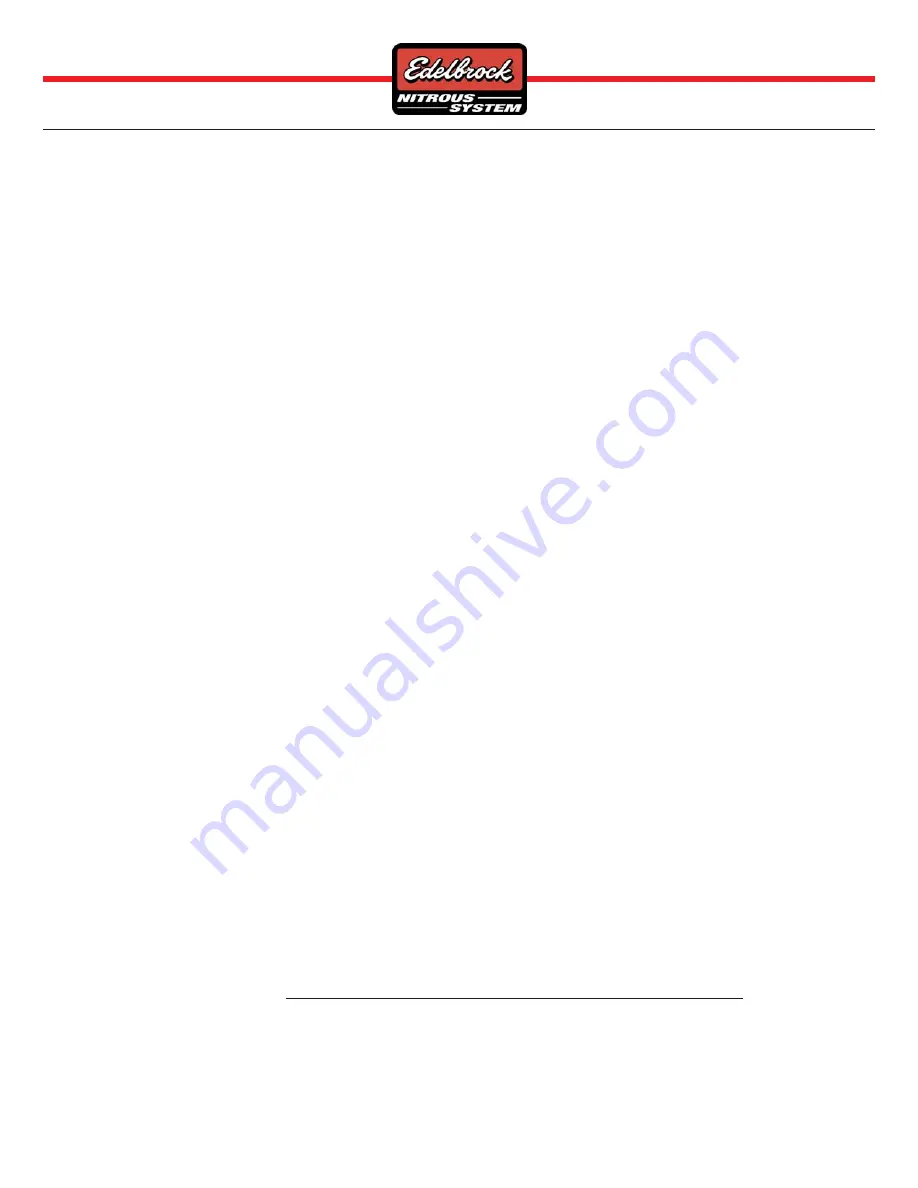
WWW.EDELBROCK.CO
M
©2007 Edelbrock Corporation
Brochure #63-70216
Page 13 of 16
Catalog #70216
Rev. 5/07 - DC/mc
4.0 Before You Run Your Vehicle Using Your Edelbrock Nitrous System
You have just completed the installation of your Edelbrock Nitrous System. It is time to perform some basic system checks to
ensure all of the work you have done is correct and ready to operate properly. The following procedure is designed to validate the
operation of your nitrous system before operating your vehicle:
Note: Before performing steps 1 through 4, make sure that the nitrous bottle is closed and main nitrous supply line
is empty of any nitrous.
4.1
Fuel System Check
1.
Hook up all battery leads.
2.
Double-Check all wires and leads for signs of heat and proper connections.
3.
Start your vehicle.
4.
Check all fittings for leaks. Pay close attention to the fuel line fittings making certain that they are all dry.
4.2
Nitrous System Check
1.
With the vehicle’s engine running, slowly open the nitrous bottle valve.
Note:
There should be no change in engine idle speed. If idle speed changes, close nitrous bottle valve immediately
and refer to the “Troubleshooting Guide” section.
2.
Inspect nitrous lines and fittings for leaks using a soapy water mixture and a small brush.
3.
If any of the fittings/connections show bubbling around the attachment nut or on the threaded area of the fitting, shut
the nitrous bottle valve off immediately and dry the fitting before attempting any service to that particular fitting
connection.
4.
If the engine idle does not come up, and all of the fittings appear to be leak-free, you have successfully completed
the installation of your Edelbrock Nitrous System.
5.o Solenoid Inspection and Maintenance
1.
Close valve on nitrous bottle.
2.
Make sure all nitrous supply lines are free of pressure before removal of any system solenoid.
a.
Empty main nitrous supply line at the nitrous bottle. Take care to not breathe or expose your skin to nitrous.
b.
Do not open pressurized fuel lines over a hot engine.
3.
Remove nitrous solenoid from the engine and securely clamp it into a vise, taking great care not to damage the solenoid.
4.
Remove the solenoid cover retaining nut from the top of the nitrous solenoids.
5.
Remove the coil and housing from the nitrous solenoid base.
6.
Unscrew the stem from the nitrous solenoid base. Do this by using a solenoid stem removal tool or by “double nutting” the
stem and unscrewing the stem from the housing body.
Do not use pliers on solenoid stem!
Damage to the stem will
result.
7.
Carefully remove the stem, spring and plunger from the solenoid base paying close attention to the way they are assembled.
8.
Examine the plunger seal for swelling, cuts and abrasions. The seal surface should be flat, except for a small circular
indentation in the center of the seal.
A seal that has been contaminated or over-pressurized will bulge from exposure to chemicals other than nitrous oxide. It
can appear to extend down from the plunger and be dome-shaped. A contaminated seal may return to its original shape if
left out in fresh air for approximately 48 hours. It may then be returned to sevice. If it does not return to its original shape,
it must be replaced.
9.
Clean the solenoid body.
Do not use an oil-based solvent to clean any part of the solenoid.
Use paint thinner or
electrical contact cleaner. Remove any contaminants that may be present. Make sure solenoid body is clean, dry and free
of oils before assembly.
10.
Replace the O-Ring, plunger and piston spring.
11.
Re-assemble the solenoid by reversing disassembly procedure.

































